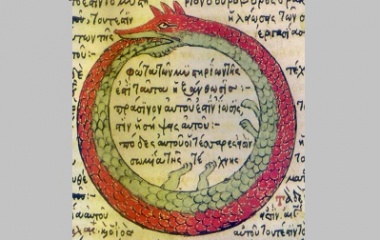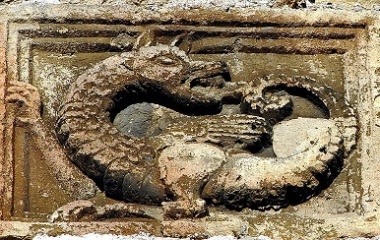The never-ending cycle of life, death, reincarnation and potential immortality have driven many philosophic and religious pursuits since ancient times. The concept is commonly represented by the symbol of a mythical serpent.
What Is an Ouroboros?
An Ouroboros is a symbol of a snake consuming its own tail. It appears in mythology and dates back to 1600 BC. The word comes from ancient Greek and means tail eater. The symbol represents life, death, renewal and infinity, and has been found on papyri and emblems and engraved on tombs.
In Egyptian Mythology
The symbol appears first in the 14th century BC, in an ancient Egyptian funerary text found in Tutankhamun’s tomb and called the Book of the Netherworld. The book contains a picture of two snakes wrapped around a god. The ouroboros was a reflection of the orderly world and the chaos which lay just beyond it. The symbol was also associated with the god Atum who was reborn every morning in the form of a snake which rose out of the water.
In Greece
The Greek philosopher Plato described a ring-shaped, self-eating being. It was the first thing to be imbued with life in the cosmos, but had no eyes or limbs. The Creator made the being self-sufficient through its circular form, and it fed itself through its own waste.
In Norse Mythology
According to Norse Mythology, the serpent Jormungand lives in the sea and encircles the whole of Midgard. He is the son of Loki and Angrboða, and his name means the great beast in Old Norse. Ragnar Lodbrock, a legendary figure in Norse sagas, had a son by a woman other than his wife and his son had an ouroboros circling his iris. He was named Sigurd, which means snake in the eye.
In Alchemy
The symbol appears in the Chrysopoeia of Cleopatra, an important alchemical text from the 2nd century AD. It was written by Cleopatra the Alchemist. She was allegedly one of only four women able to concoct the Philosopher’s Stone, the substance which could turn metals into gold and help people live longer or even become immortal. The papyrus with the serpent symbol also contained the words hen to pan meaning one is the all and, through its black and white segments, was said to illustrate the duality of life, similar to Yin and Yang in Eastern philosophy. The ouroboros, or Great World Serpent, was said to form a ring around the Earth.
It embodied purification, life and death, and also represented the element mercury in alchemy. The liquid metal combines with other metals easily and is commonly used to extract gold. Since the goal of alchemy was transmutation (changing into another condition or state), the ouroboros represented the goal of changing from an earthly to a purely spiritual state, beyond the continual cycle of birth and death, as well as changing base metals into gold.
In Gnosticism
The symbol represents eternity in Gnosticism and also refers to a dragon which eats its own tail. The Gnostics believe the world is full of suffering and that in order for life to exist and living things to survive, there must be fear, pain and death to create balance.
Other Uses
The Milky Way is said to be one of the inspirations for the ouroboros in Greek and Egyptian mythology, referring to the Milky Way as the serpent of light. The symbol of the snake, or infinity, is seen in numerous depictions in Freemasonry, such as a rope or snake in a figure-of-eight form. It features on the building fixtures of the oldest masonic lodge and in masonic seals. The seal of the Theosophical society also includes an ouroboros and represents the boundary of the universe, infinity, the cyclic nature of the universe, healing and reincarnation.
A snake which coils around and holds its own tail is mentioned in relation to Kundalini energy. In Chinese beliefs, the symbol is a reflection of the balance of male and female, as well as darkness and light. The Chinese believe both forces are needed to create Chi or creative energy. The creator god in Aztec mythology is a plumed serpent called Quetzalcoatl. It is often depicted eating its own tail.
The snake or serpent symbol appears in many ancient mythologies, representing the mystery of life, death and the afterlife, subjects which remain occluded today! Even the renowned science fiction series X-Files featured the lead female character, Dana Scully, having an ouroboros tattooed on her back, symbolizing the circular nature of existence.
Ouroboros






No comments:
Post a Comment